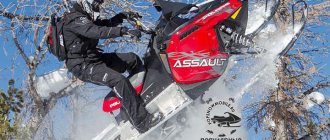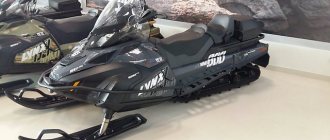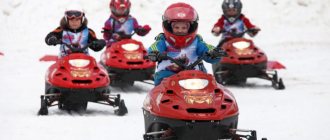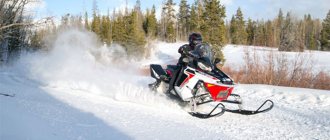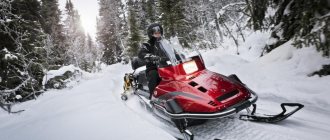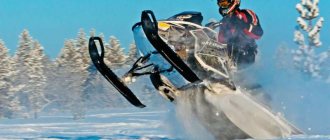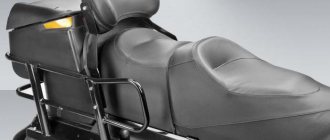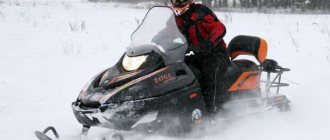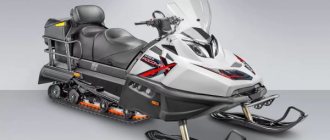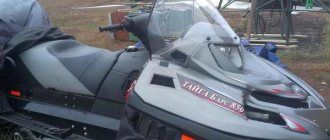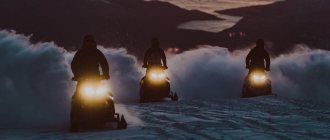Polaris RMK 800 is a universal snowmobile from a well-known brand, in demand in Russia and abroad. The model under consideration received high performance qualities, which were confirmed by factory testers, as well as ordinary users. The owners of this snowmobile are family people, as well as athletes, fishermen and hunters. Based on this, we can conclude that the car attracts not only its appearance, but also its driving characteristics. This snowmobile is the most popular on the Russian market, among other Polaris models.
Polaris RMK 800 is a multi-purpose mountain-class snowmobile designed to perform professional tasks. Thus, before us is not just a car for recreation, but also for work needs. The scope of application of the Polaris RMK 800 snowmobile is extensive and varied. The equipment is capable of towing sleds and loads, as it has a high carrying capacity. The machine can be used in mountain conditions, on a specially prepared track with compacted snow, as well as on an icy road. This model is equipped with an engine adapted to high loads. The motor does not experience problems associated with overheating or hypothermia. The power unit makes it possible to quickly reach maximum speed if it is necessary to overcome a certain section of the road within the allotted time. We must admit that this is one of the fastest snowmobiles in its price category.
The manufacturer took care of the high driving qualities of the snowmobile, and specially for this purpose equipped it with an extended Competition track, which features high lugs. This made it possible to increase geometric cross-country ability on slippery ice, as well as loose snow-covered surfaces. The rugged frame construction and proprietary Pro-Ride suspension ensure smooth passage of obstacles with a high level of comfort. In addition, the suspension and frame were significantly lighter thanks to the use of carbon materials. The QuickDrive drive system, which uses aluminum side steps, has also been significantly lightened. The rear suspension includes coil springs, which are necessary when driving in deep snow. In general, all of the above components significantly increased the vehicle’s maneuverability and improved comfort.
If necessary, you can order a special configuration designed for driving on special roads - for example, with jumps. For such conditions, a unique suspension has been developed that is resistant to jumps and other extreme conditions. Among the features of this suspension (it is installed at the front) is the absence of a stabilizer, as well as the ability to adjust the stiffness to adapt the car to certain road conditions. So, especially for this purpose, the suspension is equipped with adjustable Walker Evans shock absorbers. Among other features, we note a durable caterpillar track with special rigidity parameters. With such a caterpillar there should be no problems when moving on snowy and icy surfaces. As a result, we have a car with excellent driving characteristics, high strength and stability. At the same time, we will add simple and understandable controllability, which does not require professional skills. From this point of view, the machine can be recommended to novice users. We note the ability of the Polaris RMK 800 snowmobile to quickly overcome steep turns, as well as actively avoid obstacles - for example, stones or trees. It was possible to achieve such driving qualities not only with the help of outstanding chassis parameters, but also by reducing the weight of the structure, which uses lightweight composite materials.
Specifications
- Length – 3327 mm
- Width to body – 1181 mm
- Total height – 1247 mm
- Minimum/maximum base – 990/1040 mm
- Front/rear suspension: Axys RMK, adaptive/RMK Coil-Over
- Front shock absorbers, pcs. – 2
- Front shock absorber brand: Walker Evans
- Rear Shocks – Walker Evans Impact Extruder Monotube
- Skis – Gripper
- Front/rear suspension travel – 229/406 mm
- Propulsion - caterpillar
- Drive sprocket location – front
- Caterpillars, pcs. - 1
- Tension mechanism – screw
- Caterpillar belt – reinforced, rubber-fabric
- Track length/track width – 3937/380 mm
- Grouser height – 50 mm
- Transmission – QuickDrive, CVT P-85 Team LWT
- Gears: down, up, reverse, neutral
- Brakes – disc, Axys RMK LWT
- Brake drive – hydraulic
- Starter type – electric starter, manual starter
- Power/Ignition – Cleanfire Injection/Clean-fire 3D
- Lubrication system – oil
- Snowmobile weight – 185 kg
- Fuel tank volume – 43 liters
- Layout – single
- Exhaust System – Single, 3 Stage VES
Basic options: electric start, reverse, heated steering wheel and gas trigger functions, high windshield, passenger seat back, tow bar, reinforced bumpers front and rear, speedometer and odometer, two headlights - halogen (front) and LED (rear).
Polaris 800 Pro RMK 155 VS Ski-Doo Summit X154 800R E-TEC – COMPARISON
Duel
Polaris 800 Pro RMK 155 2013, 795 cm3, 154 l. pp., 195.5 kg
Ski-Doo Summit X154 800R E-TEC 2013, 799.5 cm3, 163 hp. pp., 208 kg
text: Yuri Solonovich photo: Dmitry Kuzmin, Sergey Milovanov
»As fate would have it, the Russian mountain snowmobile market today is divided between two long-standing and irreconcilably competing brands: the American company Polaris with its top-end “mountain snowmobile” RMK and the Canadian concern BRP with an updated machine of the Summit family. Why don't we talk about, say, the Arctic Cat M800 mountain model or the Yamaha FX Nytro, you ask? Well, at least because the Japanese stubbornly do not install 2-stroke engines, traditional for a modern mountain snowmobile, on their platform. And the Russian distributor of Arctic Cat equipment does not promote its products in the Russian Federation at all. So what remains are two direct and, perhaps, the most popular opponents.
It is these snowmobiles that have become the main fetish of almost all Russian mountain skiing enthusiasts in recent years. The associations “Ski-Doo Summit - Bret Rasmussen - SkiDooking mountain skiing school” and “Polaris RMK - Chris Burandt - Russian Snowmobile School (RSS)” allowed to radically improve sales figures in this segment. So much so that today “gorniks” are sold a little worse than their utilitarian, much more down-to-earth and inexpensive counterparts.
Fight But let's leave the dry numbers of technical characteristics aside and talk, perhaps, about the most interesting! About how snowmobiles behave in real, “combat” conditions. Which one is lighter, more powerful or handles better? Which should you prefer: the lightweight but slightly less powerful Polaris RMK or the innovative but heavier Ski-Doo Summit? Products manufactured by BRP have always been distinguished from their peers by their meticulous engineering, attention to detail and downright morbid passion for numerous technical innovations. Whatever is new is a technological and ideological breakthrough! And it doesn’t matter at all what Canadians present to the respected public: absolutely all cars, from a jet ski to a snowmobile, always have their own face and a unique and unique “zest”.
Take, for example, the new generation Summit. Old-style snowmobiles were nothing special, but the advent of REV-XM, tMotion and Flex Edge radically changed public opinion. Thanks to a new design that allows the suspension and track to repeat the angle of inclination of almost any slope within two degrees, performing a side hill maneuver or simply traversing in deep snow has become accessible even to novice snowmobilers. I think even the most seasoned specialist in this field will not argue with this. Almost any rider with basic mountain riding skills can now roll the Summit on its side and ride along the slope. Combine that with the power and responsiveness of the superb Rotax E-Tec powerplant, and you've got yourself a near-ideal mountain sled for beginners and experienced riders alike. Magnificent, technologically advanced, with a bright, memorable appearance. However, in every barrel of honey, as you know, there is always a certain amount of tar. The entire Summit family, in my opinion, has quite a lot of weight for an ultimate mountain climber. And a considerable part of it falls on the rear of the car. In addition, the “stock” settings of the variator and ignition system of models intended for the Russian market make the response to manipulations with the gas trigger too thoughtful. These two factors make digging into really deep snow a breeze on the Summit. In addition, no one has canceled the problem of periodically burning and tearing variator belts when operating a snowmobile in conditions of deep and dense snow, as well as new too wide footpegs.
Ski-Doo Summit X154 800R E-TEC The Canadian machine is built on the REV-XM platform and is powered by the traditional Ski-Doo mountain bike Rotax E-TEC 800R power plant. Engine 163.9 hp. With. has excellent elasticity and good fuel efficiency (12.3 l/100 km), which gives the device excellent autonomy (325 km on one fill-up). The Rotax engine has adequate oil consumption (1 liter per 450 km), easy starting in low temperatures and a unique automatic preservation system. The snowmobile is equipped with the revolutionary tMotion rear suspension: thanks to a new linkage design and articulation, the lower part is capable of tilting two degrees to one side or the other in the horizontal direction.
That is, when maneuvering, the tilt of the snowmobile itself is complemented by a lateral rotation/displacement of the suspension. Also, to ensure the required degree of freedom of the specially designed Powder Max II track with a lug height of 63 mm, the “slides” and support rollers were shifted from its edges to the center. This was done so that the edge of the track, which is not equipped with stiffeners (Flex-Edge technology), could bend freely when the snowmobile tilts. With a track width of 410 mm, the length of the transverse stiffening ribs is only 310 mm (whereas on conventional tracks these ribs run across the entire width). Because of this, a deformable zone 50 mm wide remains at each edge of the track. This allows the snowmobile to maneuver with the ease of a “narrow-track” vehicle, while maintaining all the advantages of a wide track - both in deep snow and on compacted trails. The front suspension is built on traditional double A-arms with HPG Plus shock absorbers with 200 mm of travel. The ski track is adjustable between 907–950 mm. For ease of movement along steep mountain slopes, special teeth are installed on the upper lever, which prevent the foot from slipping at the most inopportune moment.
In defiance of its Canadian brother, the American snowmobile is slender and fit, like an English royal grenadier on parade! During the design (which, by the way, took place with the direct participation of the legendary Chris Burandt) and production of the RMK family of devices, the Polaris concern placed its bets on their ultra-light weight. The most modern technologies coming from the high-tech aerospace industries were put into use: the use of carbon elements and adhesive joints allowed RMK to effortlessly win the title of “Lightest mountain snowmobile in the world”! It should be noted that the difference in weight, especially compared to competitors, is very noticeable. I would advise skeptics to try to pull out the Pro RMK that has begun to plunge into the deep snow abyss and, for example, any other, heavier snowmobile. If you have the appropriate skills, the American mountain climber in most cases gets out of the snow captivity on his own, after several lateral movements and appropriate operation of the gas trigger. And, for example, his Canadian counterpart, as a rule, turns out to be not so dexterous and efficient! And in general, if the rider has these very skills and is “pumped up” properly, the Polaris snowmobile, like a well-honed tool, will easily and naturally cut the surface of absolutely any slopes, regardless of their steepness and depth of snow cover. The Pro RMK's handling amazes even seasoned snowmobilers! But even such an ultimately uncompromising machine, as it turns out, is not without its drawbacks. Consider the drive shafts that were massively destroyed in their time, practically unrepairable adhesive joints of power structures, problems with the strength of the front and rear bumpers, as well as snow that accumulates in the area of the variator drive belt... Of course, all the defects, according to the manufacturer, remained in the distant teens past, but, as they say, “a sediment remains.”
Polaris 800 Pro RMK 155 The American snowmobile is equipped with the Liberty Cleanfire 800 CFI engine, well known to all fans of the brand. The 795 cc 2-stroke 2-cylinder power plant produces a modest 154 hp by today's standards. With. But, despite this, in terms of the ratio of the weight of the snowmobile to its power, the RMK is a leader in its class. It is weight that is the main advantage of the Polaris device in the competition. “Liposuction”, carried out by American engineers, allowed us to achieve absolutely amazing results: the snowmobile weighs a record 195.5 kg!
How did you manage to achieve such incredible values? First of all, thanks to the use of the QuickDrive system, in which the transmission is connected to the engine by a belt, rather than a traditional chain. Thanks to this, it was possible to reduce the weight of the machine by 3 kg and reduce parasitic inertia during rotation by 21%. Secondly, this is the merit of the composite synthetic materials used in the production of the model. The rear load-bearing structures and front load-bearing elements of the frame are made of carbon - and all connections are glued together.
Also thanks to the new design of forged aluminum lower arms, the Pro-Ride RMK front suspension is almost 900 g lighter, without losing rigidity. The A-arm front suspension features adjustable Walker Evans shock absorbers with 229 mm of travel. The track can change in the ranges of 991-1016-1041 mm. The RMK Coil-Over rear suspension features Walker Evans shock absorbers with 406 mm of travel.
So which snowmobile ultimately won this impromptu duel? Who deserves the honorary title “king of the hill”? Personally, I think both cars are good in their own way!
If you prefer long trips in the mountains, interspersed with extreme rides on snowy slopes, then your choice is quite obvious - Summit! The snowmobile is very comfortable and predictable. It allows you, even without having specialized sports skills, to storm any adequate slopes. And if you have these very skills, in skillful hands it can work wonders, without tiring the rider too much. But if such terms as boondocking, side hill and hop over are not empty words for you and you consider riding a mountain snowmobile primarily as a sport, you should take a closer look at the Polaris Pro RMK. It is he who will make you feel all the charm of a technically correctly performed trick and will fully allow you to enjoy crazy and uncompromising movements along slopes overgrown with dense dense vegetation. /
Engine
The Polaris RMK 800 snowmobile is equipped with a gasoline power unit from the environmentally friendly Liberty family of Polaris' own production. The engine has a compact two-cylinder layout with a displacement of 800 cc. cm. Each cylinder is 85 mm long and the piston stroke is 70 mm. The engine develops 154 horsepower, which is one of the best figures in its class. The unit is equipped with liquid cooling with a restart function. The multifunctional cooling system provides the ability to work not only in frosty, but also in relatively warm seasons - for example, at temperatures above zero degrees. The motor will not experience overheating. For uninterrupted operation of the engine in frosty conditions, an electric starter and a pre-heater help well, without which it is hardly possible to do at minus 40 degrees and below. As practice and factory tests show, the average gasoline consumption of a Liberty family engine is 16-17 liters per 100 km.
Price
The average cost of a Polaris 800 snowmobile on the Russian market is 1 million 200 thousand rubles. The price is for a new car for the basic configuration. As for a used snowmobile, its final cost depends on the technical condition, mileage and year of manufacture. Thus, the estimated price of the RMK 800 model is 850 thousand - 1.1 million rubles. The manufacturer provides a warranty period of 12 months for a new snowmobile. In the event of problems occurring within the specified period, the owner has the right to receive a free service from the service to eliminate the problem.
Reviews
- Daniil, Magnitogorsk. Not a bad snowmobile. Only very expensive. At the end of 2022, the car cost me 1.2 million rubles. This model impressed me, and I primarily noted its stylish design, excellent handling and powerful engine. The RMK 800 model is capable of driving on compacted snow and icy roads, as well as on loose snowy terrain. In short, this snowmobile rushes like a tank and does not cause any problems. I've been using it for about 4 months. Sharp steering and wide tracks contribute to excellent maneuverability and directional stability. I often go hunting and fishing with my men; by the way, they also have imported snowmobiles. In terms of handling, my car is on par with the Japanese Yamaha. I hope that Polaris will continue to please me with its reliability. I only fill up with oil and fuel. By the way, the snowmobile officially supports 92nd gasoline.
- Boris, Nizhny Novgorod region. A good car for every day. I would like to note the high-quality finishing materials that immediately catch the eye, as well as the perfectly fitted details. In general, the build quality is excellent. This is the first impression. In two months I drove more than 1000 kilometers - I really liked the car, it doesn’t break down at all. I am sure that this will continue to happen. At speeds above 80 km/h, fuel consumption increases, but this is quite natural, and it’s a sin to complain. The windshield seemed a little low to me - because of this, the cold wind hits me directly in the face, which, to put it mildly, is not very pleasant. This seems like a small thing, but at the same time it is a serious drawback for such an expensive snowmobile. I had to buy a helmet, and now everything is fine.
- Garik, Yaroslavl region. A too expensive snowmobile, which I still decided to buy. It has a power of more than 150 hp. s., and from this a certain confidence and pride in the car appears. But these are only the first sensations, since in practice there is nothing like this. Of course, the engine has good dynamics, accelerates quickly, but without spark. This is absolutely not a sports snowmobile - believe me, I have ridden real racing snowmobiles, which the RMK 800 model is no match for. A heavy but overly sensitive steering wheel, sharp but somewhat nervous handling, a stiff suspension and a low windshield are all design flaws that you cannot fix on your own. Fuel consumption is too high for a home snowmobile, especially at maximum speeds. The model has never broken down in two months – well, at least that’s a good thing, but still the price is very high. I cannot recommend this model for purchase, as there are serious shortcomings in terms of controllability and efficiency.
“Polaris Sportsman X-2” received a powerful engine
A good engine for a four-wheeler is perhaps even more important than for a car. After all, both the controllability and cross-country ability of an ATV depend on traction. An example of this is the Polaris Sportsman X-2 500 EFI, which appeared on the market a year ago. A full-size vehicle with an excellent chassis, which, by the way, was the first of its kind to receive a transformable passenger seat. But here's the engine! It’s strange that Polaris engineers didn’t immediately realize: 500 “cubes” is clearly not enough for a two-seater four-wheeler. However, less than a year passed before they realized it. Perhaps the competitors who were pushing in from all sides helped. Here you have the new “Arctic Cat 650H1 TRV PLUS”, and the “Kawasaki KVF650 4x4” with a two-cylinder engine, and the very powerful “Sea-Doo Outlander MAX800XT” with a V-shaped “eight hundred”. And then, you see, the Chinese will arrive in time: they also have a “five hundred” in their two-seater ATV, but that’s just for now.. In general, you shouldn’t be surprised that after the 500 cc predecessor, the “Sportsman X-2” has now appeared. with a two-cylinder branded engine “Liberty 800”. Translated – “freedom 800”. Well, let's see how much freer the four-wheeler's habits have become thanks to the "eight hundred"..
